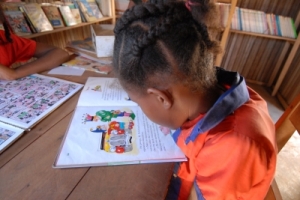My husband and I immersed ourselves in the Hispanic culture of Richmond this weekend as we went to Spanish Mass. Originally we planned to go to Vietnamese Mass in another city, which would have been a severe language difference, but it didn't work out.
[caption id="attachment_110" align="alignright" width="198"]

Me when I realized I wasn't drowning in language! [Image courtesy of FreeDigitalImages.net][/caption]My academic background includes about six years of Spanish language classes and a little experience practicing my Spanish language acquisition among friends in the United States. This was an entirely different level of immersion as there were no breaks, no opportunities for others to recast for me, and no English translations or scaffolding.
Despite the high percentage of vocabulary words I was unfamiliar with during the Mass, to my pure delight I understood the majority of what was going on. Yay! All of those years of school and studying paid off today!
First of all, I am a devout Catholic and am very familiar with the procedures of the Mass, which is the same wherever one goes and in every language (big perk, aside from the many others). Also, I
brought the readings (which are prescribed ahead of time and universal for today around the world in the Catholic Church) with me so I could consult them. This helped me become familiar enough with the language and my surroundings to lower my
affective filter.
Additionally, I sang along with the help of the worship songbook without worrying about mispronouncing the words because I was with my husband (someone who doesn't, of course, judge me for mispronunciations...or lack of singing talent).
The church was packed and the people who sat around us were quite welcoming during a part of the Mass in which everyone turns to their neighbor to offer the peace of Christ. I love this brother/sisterhood!
As a qualitatively minded person, my first reaction was to reflect first on the cultural aspects of attending Mass in a language with which I have only novice familiarity. However, in reflecting on my knowledge of SLA and the most effective way to acquire a second language, I cannot wait to go back!
Attending Mass, striking up more conversations with those around me, and comparing the Spanish and English translations as I use them during an event with which I have so much familiarity would be a Krashen-approved language acquisition activity. My husband and I have spoken about making this a regular challenge for the sake of our own language acquisition and community involvement.
 Pretty little trees, happy little clouds.[/caption]
Pretty little trees, happy little clouds.[/caption]
 *woman[/caption]
*woman[/caption] meow?[/caption]
meow?[/caption]




![Image courtesy of [image creator name] / FreeDigitalPhotos.net](http://teachingseconds.files.wordpress.com/2013/06/id-1009182.jpg?w=300)
